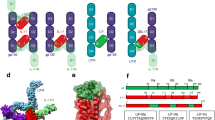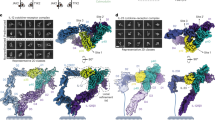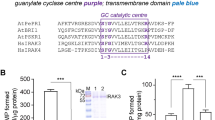Abstract
Interleukin-22 (IL-22), a member of IL-10 family, plays some important roles in immune response through activation of the STAT 3 signal transduction pathway. Two types of IL-22-binding receptor have been discovered, a membrane-bound receptor and a soluble receptor, both encoded by different genes. IL-22 may be involved in inflammatory processes specifically regulated by soluble receptors. By screening a mouse genomic library for a human IL-22 binding protein homologue, we identified the mouse genomic clone of IL-22 binding protein. Its coding sequence was verified and isolated by RT–PCR. The gene encodes a protein of 230 amino acids that share 67.1% amino-acid sequence identity with human IL-22 binding protein. We designated this receptor ‘mouse IL-22 binding protein’ (mIL-22BP). mIL-22BP could be upregulated by LPS stimulation in mouse monocytes. mIL-22BP binds to mouse and human IL-22 and neutralizes STAT3 activation induced by both cytokines in human and rat hepatoma cell lines. Treating B cells with mouse IL-22 induces production of reactive oxygen species, which mIL-22BP blocks.
This is a preview of subscription content, access via your institution
Access options
Subscribe to this journal
Receive 6 digital issues and online access to articles
$119.00 per year
only $19.83 per issue
Buy this article
- Purchase on Springer Link
- Instant access to full article PDF
Prices may be subject to local taxes which are calculated during checkout







Similar content being viewed by others
References
Dinarello CA . Proinflammatory cytokines. Chest 2000; 118: 503–508.
Moore KW, de Waal Malefyt R, Coffman RL, O'Garra A . Interleukin-10 and the interleukin-10 receptor. Annu Rev Immunol 2001; 19: 683–765.
Moore KW, Vieira P, Fiorentino DF, Trounstine ML, Khan TA, Mosmann TR . Homology of cytokine synthesis inhibitory factor (IL-10) to the Epstein–Barr virus gene BCRFI. Science 1990; 248: 1230–1234.
Thompson-Snipes L, Dhar V, Bond M, Mosmann T, Moore K, Rennick D . Interleukin 10: a novel stimulatory factor for mast cells and their progenitors. J Exp Med 1991; 173: 507–510.
Rousset F, Garcia E, Defrance T et al. Interleukin 10 is a potent growth and differentiation factor for activated human B lymphocytes. Proc Natl Acad Sci USA 1992; 89: 1890–1893.
Go N, Castle B, Barrett R et al. Interleukin 10, a novel B cell stimulatory factor: unresponsiveness of X chromosome-linked immunodeficiency B cells. J Exp Med 1990; 172: 1625–1631.
Gallagher DH, Eskdale G, Izotova LS et al. Cloning, expression and initial characterization of interleukin-19 (IL-19), a novel homologue of human interleukin-10 (IL-10). Genes Immun 2000; 1: 442–450.
Blumberg CD, Xu WF, Grossmann A et al. Interleukin 20: discovery receptor identification, and role in epidermal function. Cell 2001; 104: 9–19.
Ellerhorst JA, Prieto VG, Ekmekcioglu S et al. Loss of MDA-7 expression with progression of melanoma. J Clin Oncol 2002; 20: 1069–1074.
Knappe A, Hor S, Wittmann S, Fickenscher H . Induction of a novel cellular homolog of interleukin-10, AK155, by transformation of T lymphocytes with herpesvirus saimiri. J Virol 2000; 74: 3881–3887.
Dumoutier L, Louahed J, Renauld J-C . Cloning and characterization of IL-10-related T cell-derived inducible factor (IL-TIF), a novel cytokine structurally related to IL-10 and inducible by IL-9. J Immunol 2000; 164: 1814–1819.
Dumoutier L, Van Roost E, Colau D, Renauld J-C . Human interleukin-10-related T cell-derived inducible factor: molecular cloning and functional characterization as an hepatocyte-stimulating factor. Proc Natl Acad Sci USA 2000; 97: 10144–10149.
Aggarwal S, Xie MH, Maruoka M, Foster J, Gurney AL . Acinar cells of the pancreas are a target of interleukin-22. J Interferon Cytokine Res 2001; 21: 1047–1053.
Xie M-H, Aggarwal S, Ho W-H et al. Interleukin (IL)-22, a novel human cytokine that signals through the interferon receptor-related proteins CRF2-4 and IL-22R. J Biol Chem 2000; 275: 31335–31339.
Dumoutier L, Lejeune D, Colau D, Renauld J-C . Cloning and characterization of IL-22 binding protein, a natural antagonist of IL-10-related T cell-derived inducible factor/IL-22. J Immunol 2001; 166: 7090–7095.
Kotenko SV, Izotova LS, Mirochnitchenko OV et al. Identification, cloning, and characterization of a novel soluble receptor that binds IL-22 and neutralizes its activity. J Immunol 2001; 166: 7096–7103.
Xu W, Presnell SR, Parrish-Novak J et al. A soluble class II cytokine receptor, IL-22RA2, is a naturally occurring IL-22 antagonist. Proc Natl Acad Sci USA 2001; 98: 9511–9516.
Liao Y-C, Liang W-G, Chen F-W, Hsu J-H, Yang J-J, Chang M-S . IL-19 induces production of IL-6 and TNF-{alpha} and results in cell apoptosis through TNF-{alpha}. J Immunol 2002; 169: 4288–4297.
Dokka S, Shi X, Leonard S, Wang L, Castranova V, Rojanasakul Y . Interleukin-10-mediated inhibition of free radical generation in macrophages. Am J Physiol Lung Cell Mol Physiol 2001; 280: L1196–L1202.
Fedyk ER, Phipps RP . Reactive oxygen species and not lipoxygenase products are required for mouse B-lymphocyte activation and differentiation. Int J Immunopharmacol 1994; 16: 533–546.
Buttke TM, Sandstrom PA . Redox regulation of programmed cell death in lymphocytes. Free Radic Res 1995; 22: 389–397.
Dobmeyer TS, Findhammer S, Dobmeyer JM et al. Ex vivo induction of apoptosis in lymphocytes is mediated by oxidative stress: role for lymphocyte loss in HIV infection. Free Radic Biol Med 1997; 22: 775–785.
Author information
Authors and Affiliations
Corresponding author
Additional information
The nucleotide sequences of mouse binding protein have been deposited in the GenBank database with accession number AF493604.
Rights and permissions
About this article
Cite this article
Wei, CC., Ho, TW., Liang, WG. et al. Cloning and characterization of mouse IL-22 binding protein. Genes Immun 4, 204–211 (2003). https://doi.org/10.1038/sj.gene.6363947
Received:
Revised:
Accepted:
Published:
Issue Date:
DOI: https://doi.org/10.1038/sj.gene.6363947
Keywords
This article is cited by
-
Interleukin-22: a potential therapeutic target in atherosclerosis
Molecular Medicine (2021)
-
The good and the bad about separation anxiety: roles of IL-22 and IL-22BP in liver pathologies
Seminars in Immunopathology (2021)
-
Biological and pathological activities of interleukin-22
Journal of Molecular Medicine (2016)
-
Therapeutic opportunities of the IL-22–IL-22R1 system
Nature Reviews Drug Discovery (2014)
-
Clinical Consequences of Targeting IL-17 and TH17 in Autoimmune and Allergic Disorders
Current Allergy and Asthma Reports (2013)



